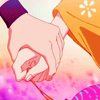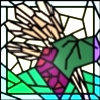A ce sujet, je quote un post de 'slippy' sur le personnage de Lucy, tiré du forum de animenfo. J'ai trouvé ce post particulièrement intéressant. Anglophobes s'abstenir.
Citation
For me, it still comes down to trauma, hatred, and mental/psychic violence, and how these things can be manipulated through narrative order and exploitation-style tropes ( . . and perhaps a sort of Marxist train of art criticism that goes along with the whole Joan of Arc-isms in anime.) Also, Elfen Lied uses a very effective J-horror trope of having the monster be apparently a functional robot; that is, an abomination completely designed and identified with her function, yet without he attitude, apparent grotesquerie, inability to be manipulated or reasoned with, etc.
But it also comes down to the stunning visual style, particularly in Lucy's character designs and artwork. I just love Lucy as a character composition. I'm not really speaking from the novelistic standpoint of character development or sympathetic persusation, but rather, from the marvelous visual intepretation with which the artists seem to have invested with Lucy.
Lucy is an aesthetic monster, a species who is disgusting by her heterogeneous summation. For significant moments of the story, all of Lucy is vividly depicted as The Eye (and her invisible hands), that singular painterly blood dot peering through the shadows 'round her red tangled hair. That if you see the Eye, you would be completely powerless to stop it, lest be ripped to shreds. Because we the viewers associate her Eye with the transformation, we cannot but help view her Lucy form as a complete, merciless evil. The character design does such a marvelous of making this part dominate the whole, so as we the viewer come to view Nyuu as the absence of that one thing. It is Satan itself.
And, yet, this is not how we are introduced to Lucy. The Gustave Klint-style opening sequence actually has her eyes closed. Because we do not recognize the Eye in Lucy, we come to notice her body. Or more specifically how her body seems to be recognized erotically ill at ease. We recognize her womanliness from a fan service perspective, sure, but here the artists deliberately force us not to view her as not a set of parts (which would be the usual ecchi way of doing things), but here the moon behind the sun, the undercurring sadness in her soul when we don't see the rage. And they do this here by blending very strong bishoujo tropes, almost maternal poses, that take your attention away from her nudity, and more toward her nakedness. And what embraces. That is, she embraces, true to the Gustave homage, are parts of a human, the dismemberments from the monstrosity giving and taking the incongruous love in her soul. Lucy know this too.
Elfen Lied's artwork depicts her worthlessness, her sense of love, as well as her rage and hostility as a chimera. It is all in there, but not integrated in anyway acceptable to humanity. Therefore, she's a monstrosity. But as a monster, she reflects the incomprehensible fissures of her world/society. Then she eats it while the differences are screaming for mercy.
I'm really fascinated with Elfen Lied, because it sells me on the ancient idea that we all suffer into the truth, and that the truth is a real peace. The suffering it levies, so far, is to traumatize me and recognize that same trauma with Nyuu and the boy. The completeness of this effects lays siege beyond intellectual perception, beyond anime's conventional domestication of all evil. But the incalculable, nondescript truth seems to be slowly, phantasmagorically revealing itself. And, so, what I'm not seeing is so much the literalization of hatred, horror, and love, but the poetics of hatred, horror, and love.
Her unresolved violence seems to turn Elfen Lied into a romantic phantasmagoria. There is so much blood that the blood in turn seems to be a sometimes accidental flow of love and affection, when all which has gone wrong. Until all the blood (or everybody's) is shed, until the world is as red and slathered as her eye, can she find the love beneath the blood. For, then, the Eye sees Herself, and that she is more than that part, and that she is no longer the monster, but the pure.
If Elfen Lied can arrive at that appalling purity for Lucy, this will be a unbelievable achievement for anime. But if it becomes an apologia for her bad ways or a harem romanticization of simple pet Nyuu . . .
But it also comes down to the stunning visual style, particularly in Lucy's character designs and artwork. I just love Lucy as a character composition. I'm not really speaking from the novelistic standpoint of character development or sympathetic persusation, but rather, from the marvelous visual intepretation with which the artists seem to have invested with Lucy.
Lucy is an aesthetic monster, a species who is disgusting by her heterogeneous summation. For significant moments of the story, all of Lucy is vividly depicted as The Eye (and her invisible hands), that singular painterly blood dot peering through the shadows 'round her red tangled hair. That if you see the Eye, you would be completely powerless to stop it, lest be ripped to shreds. Because we the viewers associate her Eye with the transformation, we cannot but help view her Lucy form as a complete, merciless evil. The character design does such a marvelous of making this part dominate the whole, so as we the viewer come to view Nyuu as the absence of that one thing. It is Satan itself.
And, yet, this is not how we are introduced to Lucy. The Gustave Klint-style opening sequence actually has her eyes closed. Because we do not recognize the Eye in Lucy, we come to notice her body. Or more specifically how her body seems to be recognized erotically ill at ease. We recognize her womanliness from a fan service perspective, sure, but here the artists deliberately force us not to view her as not a set of parts (which would be the usual ecchi way of doing things), but here the moon behind the sun, the undercurring sadness in her soul when we don't see the rage. And they do this here by blending very strong bishoujo tropes, almost maternal poses, that take your attention away from her nudity, and more toward her nakedness. And what embraces. That is, she embraces, true to the Gustave homage, are parts of a human, the dismemberments from the monstrosity giving and taking the incongruous love in her soul. Lucy know this too.
Elfen Lied's artwork depicts her worthlessness, her sense of love, as well as her rage and hostility as a chimera. It is all in there, but not integrated in anyway acceptable to humanity. Therefore, she's a monstrosity. But as a monster, she reflects the incomprehensible fissures of her world/society. Then she eats it while the differences are screaming for mercy.
I'm really fascinated with Elfen Lied, because it sells me on the ancient idea that we all suffer into the truth, and that the truth is a real peace. The suffering it levies, so far, is to traumatize me and recognize that same trauma with Nyuu and the boy. The completeness of this effects lays siege beyond intellectual perception, beyond anime's conventional domestication of all evil. But the incalculable, nondescript truth seems to be slowly, phantasmagorically revealing itself. And, so, what I'm not seeing is so much the literalization of hatred, horror, and love, but the poetics of hatred, horror, and love.
Her unresolved violence seems to turn Elfen Lied into a romantic phantasmagoria. There is so much blood that the blood in turn seems to be a sometimes accidental flow of love and affection, when all which has gone wrong. Until all the blood (or everybody's) is shed, until the world is as red and slathered as her eye, can she find the love beneath the blood. For, then, the Eye sees Herself, and that she is more than that part, and that she is no longer the monster, but the pure.
If Elfen Lied can arrive at that appalling purity for Lucy, this will be a unbelievable achievement for anime. But if it becomes an apologia for her bad ways or a harem romanticization of simple pet Nyuu . . .
 Aide
Aide


 Blue
Blue Green
Green Red
Red Black
Black















 >_<
>_<
